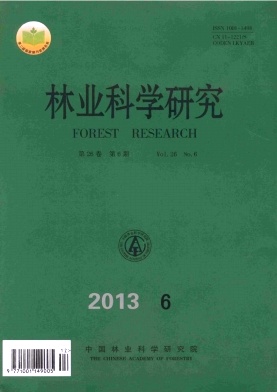|
[1]
|
Lee H J, Ravn M M, Coates R M. Synthesis and characterization of abietadiene, levopimaradiene, palustradiene, and neoabietadiene: hydrocarbon precursors of the abietane diterpene resin acids[J]. Tetrahedron, 2001, 57(29): 6155-6177 |
|
[2] Mergen F, Hoekstra P E, Echols R M. Genetic control of oleoresin yield and viscosity in slash pine[J]. Forest Science, 1955, 1(1): 19-30 |
|
[3] Chudnyi A V, Prokazin E P. Geographical variation in the composition of turpentine oils of Pinus sylvestris on the territory of the USSR[J]. Rastitel'nye Resursy, 1973, 9(4): 494-503 |
|
[4] Tadesse W, Nanos N, Aunon F J, et al. Evaluation of high resin yielders of Pinus pinaster Ait.[J]. For Gen, 2001, 8(4): 271-278 |
|
[5] Fries A, Ericsson T, Gref R. High heritability of wood extractives in Pinus sylvestris progeny tests[J]. Can J For Res, 2000, 30(11): 1707-1713 |
|
[6] Roberds J H, Strom B L, Hain F P, et al. Estimates of genetic parameters for oleoresin and growth traits in juvenile loblolly pine[J]. Can J For Res, 2003, 33(12): 2469-2476 |
|
[7] Hodges J D, Elam W W, Watson W F, et al. Oleoresin characteristics and susceptibility of four southern pines to southern pine beetle (Coleoptera: Scolytidae) attacks[J]. Can Entomol, 1979, 111(8): 889-896 |
|
[8] Lorio P L J, Stephen F M, Paine T D, et al. Environment and ontogeny modify loblolly pine response to induced acute water deficits and bark beerle attacks[J]. For Ecol Manage, 1995, 73(1-3): 97-110 |
|
[9] Strom B L, Goyer R A, Ingram Jr. L L, et al. Oleoresin characteristics of progeny of loblolly pines that escaped attack by the southern pine beetle[J]. For Ecol Manage, 2002, 158(1-3): 169-178 |
|
[10]
|
[10] Wallin K F, Kolb T E, Skov K R, et al. Effects of crown scorch on ponderosa pine resistance to bark beetles in Northern Arizona[J]. Environ Entomol, 2003,32(3): 652-661 |
|
[11]
|
[11] Tisdale R A, Nebeker T E, Hodger J D. The role of oleoresin flow in the induced response of loblolly pine to a southern pine beetle associated fungus[J]. Can J Bot, 2003, 81(4): 368-374 |
|
[12]
|
[12] Medeiros R S, Vieira G. Sustainability of extraction and production of copaiba (Copaifera multijuga Hayne) oleoresin in Manaus[J]. Am Brazil For Ecol Manage, 2008, 256(3): 282-288 |
|
[13]
|
[13] 蔡邦平,梁一池,吴端正. 马尾松高产脂优树选择方法的研究[J]. 福建林学院学报, 1998, 18(1): 32-35
|
|
[14]
|
[14] 连辉明,何波祥,曾令海,等. 马尾松速生、优质及高产脂半同胞家系综合选择的研究[J]. 广东林业科技, 2002, 18(1): 1-6
|
|
[15]
|
[15] 刘月蓉. 高产脂马尾松优树自由授粉家系及其单株选择[J]. 福建林业科技, 2005, 32(3): 122-124
|
|
[16]
|
[16] 刘月蓉. 高产脂马尾松半同胞的产脂力优良单株的选择[J]. 林业科技, 2006, 31(3): 1-4
|
|
[17]
|
[17] 覃 冀,连辉明,曾令海,等. 高产脂马尾松半同胞子代20年生测定林产脂力分析[J]. 广东林业科技, 2005, 21(2): 30-34
|
|
[18]
|
[18] 李思广,付玉嫔,张快富,等. 高产脂思茅松半同胞子代测定[J]. 浙江林学院学报, 2008, 25(2): 158-162
|
|
[19]
|
[19] 翁海龙,陈宏伟,段安安,等. 思茅松高产脂优树选择[J]. 西北林学院学报, 2010, 25(3): 71-74,79
|
|
[20]
|
[20] 周志春,傅玉狮,吴天林. 马尾松生长和材性的地理遗传变异及最优种源区的划定[J]. 林业科学研究, 1993, 6(5): 556-564
|
|
[21]
|
[21] 沈熙环. 林木育种学[M]. 北京:中国林业出版社, 1990
|
|
[22]
|
[22] 唐启义,冯明光. DPS数据处理系统[M]. 北京:科学出版社, 2007
|
|
[23]
|
[23] Cannac M, Barboni T, Ferrat L, et al. Oleoresin flow and chemical composition of Corsican pine (Pinus nigra subsp. Laricio) in response to prescribed burnings[J]. For Ecol Manage, 2009, 257(4): 1247-1254 |
|
[24]
|
[24] 蔡树威,龙 伟,杨章旗. 马尾松不同种源采脂量与树体因子关系的研究[J]. 广西林业科学, 2006, 35(增刊): 18-19
|
|
[25]
|
|





 DownLoad:
DownLoad: